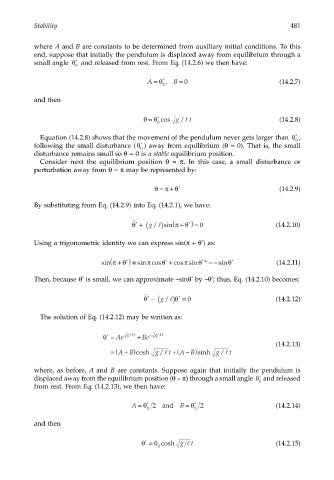Page 500 - Dynamics of Mechanical Systems
P. 500
0593_C14_fm Page 481 Tuesday, May 7, 2002 6:56 AM
Stability 481
where A and B are constants to be determined from auxiliary initial conditions. To this
end, suppose that initially the pendulum is displaced away from equilibrium through a
small angle θ * and released from rest. From Eq. (14.2.6) we then have:
0
*
A = θ , B = 0 (14.2.7)
0
and then
=
l
*
θθ cos g / t (14.2.8)
0
Equation (14.2.8) shows that the movement of the pendulum never gets larger than θ * 0 ,
following the small disturbance (θ * ) away from equilibrium (θ = 0). That is, the small
0
disturbance remains small so θ = 0 is a stable equilibrium position.
Consider next the equilibrium position θ = π. In this case, a small disturbance or
perturbation away from θ = π may be represented by:
θ =+ * (14.2.9)
π θ
By substituting from Eq. (14.2.9) into Eq. (14.2.1), we have:
(
)
+
˙˙* / sin π θ ) = 0 (14.2.10)
l
*
θ + (g
*
Using a trigonometric identity we can express sin(π + θ ) as:
(
π
sin πθ ) ≡ sin cosθ + cos sinθ * * = − sinθ * (14.2.11)
+
π
*
*
*
*
*
Then, because θ is small, we can approximate –sinθ by –θ ; thus, Eq. (14.2.10) becomes:
˙˙* / θ ) l * = 0 (14.2.12)
θ − (g
The solution of Eq. (14.2.12) may be written as:
*
θ = Ae g / tl + Be − g / tl
(14.2.13)
− )
+ )
/ t
= (AB cosh g l + (AB sinh g l
/ t
where, as before, A and B are constants. Suppose again that initially the pendulum is
displaced away from the equilibrium position (θ = π) through a small angle θ * and released
0
from rest. From Eq. (14.2.13), we then have:
*
*
A = θ 2 and B = θ 2 (14.2.14)
0 0
and then
θ = θ cosh g l t (14.2.15)
*
0

